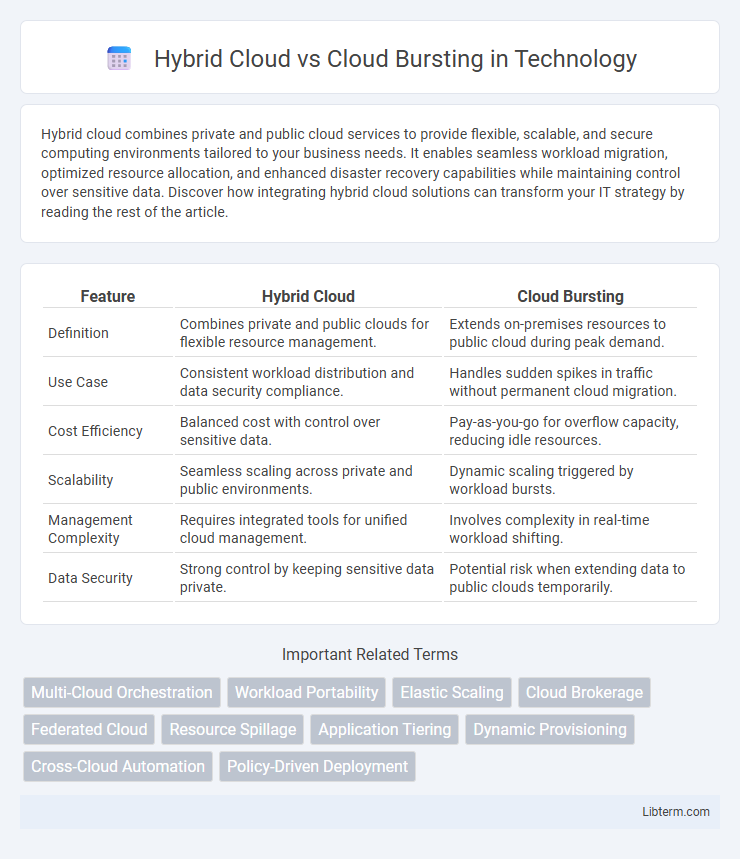Hybrid cloud combines private and public cloud services to provide flexible, scalable, and secure computing environments tailored to your business needs. It enables seamless workload migration, optimized resource allocation, and enhanced disaster recovery capabilities while maintaining control over sensitive data. Discover how integrating hybrid cloud solutions can transform your IT strategy by reading the rest of the article.
Table of Comparison
| Feature | Hybrid Cloud | Cloud Bursting |
|---|---|---|
| Definition | Combines private and public clouds for flexible resource management. | Extends on-premises resources to public cloud during peak demand. |
| Use Case | Consistent workload distribution and data security compliance. | Handles sudden spikes in traffic without permanent cloud migration. |
| Cost Efficiency | Balanced cost with control over sensitive data. | Pay-as-you-go for overflow capacity, reducing idle resources. |
| Scalability | Seamless scaling across private and public environments. | Dynamic scaling triggered by workload bursts. |
| Management Complexity | Requires integrated tools for unified cloud management. | Involves complexity in real-time workload shifting. |
| Data Security | Strong control by keeping sensitive data private. | Potential risk when extending data to public clouds temporarily. |
Introduction to Hybrid Cloud and Cloud Bursting
Hybrid cloud integrates private and public cloud resources, enabling seamless data and application portability for enhanced flexibility and cost-efficiency. Cloud bursting allows on-premises applications to dynamically expand into the public cloud during peak demand, optimizing resource utilization without permanent infrastructure investment. Both approaches address scalability, but hybrid cloud provides a long-term mixed environment while cloud bursting handles temporary workload spikes.
Defining Hybrid Cloud Architecture
Hybrid cloud architecture integrates private and public cloud environments, enabling seamless data and application portability across platforms. It offers enhanced flexibility, scalability, and optimized resource utilization by combining on-premises infrastructure with public cloud services. This architecture supports diverse workloads and regulatory compliance through customizable deployment models tailored to organizational needs.
Understanding Cloud Bursting Technology
Cloud bursting technology enables an on-premises private cloud or data center to dynamically extend into a public cloud, automatically allocating additional resources during peak demand to prevent system overload. It leverages cloud bursting as a cost-effective solution for handling traffic spikes without permanently investing in excess capacity, ensuring applications maintain performance and availability. Hybrid cloud environments support cloud bursting by integrating private infrastructure with multiple public cloud services, facilitating seamless workload mobility and scalability.
Key Differences Between Hybrid Cloud and Cloud Bursting
Hybrid Cloud integrates private and public cloud infrastructures to create a unified, flexible environment for managing diverse workloads. Cloud Bursting is a deployment model that extends an on-premises or private cloud capacity to a public cloud during peak demand, ensuring scalability without permanent infrastructure expansion. Unlike Hybrid Cloud's continuous resource blending, Cloud Bursting activates public cloud resources only as needed, optimizing cost and performance during traffic spikes.
Core Benefits of Hybrid Cloud Solutions
Hybrid cloud solutions provide seamless integration between private and public cloud environments, enabling enhanced data security and regulatory compliance. They offer scalable resource management with cost optimization by leveraging on-premises infrastructure alongside cloud services. Core benefits include improved business agility, optimized workload distribution, and greater control over sensitive applications and data.
Advantages of Implementing Cloud Bursting
Cloud bursting enables organizations to seamlessly scale their on-premises infrastructure by offloading peak workloads to public cloud resources, reducing capital expenditure and avoiding over-provisioning. This approach enhances application performance during traffic spikes while maintaining control over sensitive data stored in private environments. Leveraging cloud bursting improves resource utilization efficiency and ensures business continuity through rapid responsiveness to fluctuating demands.
Common Use Cases for Hybrid Cloud
Hybrid cloud commonly supports industries requiring data sovereignty and flexible workloads, such as healthcare managing sensitive patient records alongside scalable research environments. Enterprises leverage hybrid clouds to optimize cost-performance by combining on-premises infrastructure with public cloud resources for predictable base loads and dynamic peak demands. Organizations in retail and finance benefit from hybrid cloud's ability to enhance disaster recovery strategies while maintaining compliance with regulatory requirements.
Typical Scenarios for Cloud Bursting
Cloud bursting is typically used in scenarios where on-premises data centers handle regular workloads but require additional cloud resources during peak demand, such as e-commerce sites during holiday sales or media streaming during major events. This approach allows enterprises to manage cost-efficient scalability by offloading excess traffic to public clouds without permanently expanding infrastructure. Hybrid cloud environments integrate private and public clouds for flexible resource allocation, whereas cloud bursting specifically enables dynamic overflow to the public cloud under high load conditions.
Challenges and Limitations of Both Approaches
Hybrid cloud faces challenges in integration complexity, security management, and consistent performance across diverse environments, often requiring advanced orchestration tools and policies. Cloud bursting encounters limitations such as unpredictable cost spikes, latency issues due to data transfer between private and public clouds, and difficulties in maintaining application state and session persistence during scaling events. Both approaches demand robust network connectivity and sophisticated monitoring to mitigate risks of data breaches, compliance violations, and service disruptions.
Choosing the Right Strategy: Hybrid Cloud vs Cloud Bursting
Choosing the right strategy between hybrid cloud and cloud bursting depends on your organization's workload demands and scalability needs. Hybrid cloud offers a balanced approach by integrating private and public clouds for consistent, secure data management, while cloud bursting optimizes peak load handling by extending private cloud capacity to public cloud resources temporarily. Evaluating factors such as cost efficiency, workload predictability, and security requirements ensures optimal cloud resource utilization and business agility.
Hybrid Cloud Infographic

 libterm.com
libterm.com